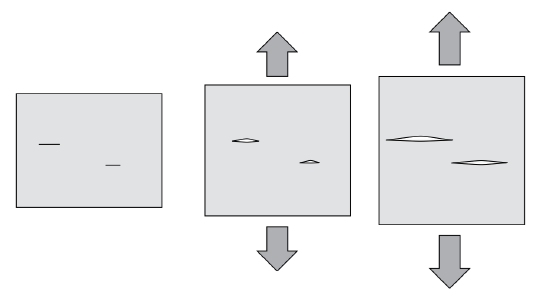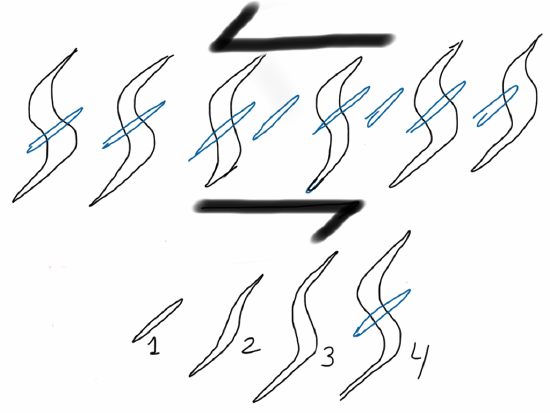1B: Fractures
- Page ID
- 1333
This page is a draft and is under active development.
A fracture is any break where cohesion, the binding between particles, has been overcome. When no displacement has occurred after the fracture has formed, this fracture is called a joint; if displacement by sliding has occurred, it is a fault; and if opening has happened, it is called a fissure.
Fracture Propagation
Fractures propagate by three different modes. Mode I fractures are gaps opening under extension, propagating as tension acts on all sides of a growing crack. These fractures are most often found near the surface, where overburden pressure is low enough to allow them to form. Fissures, as well as most joints, form by fracture mode I.
Mode II and Mode III fractures are both types of shear fracture. In mode II fracture, the shear direction is perpendicular to the direction of fracture propagation. One side of the crack is under extension while the other is compressed, extending the crack by both pushing and pulling. Mode III fractures occur when shear is perpendicular to the crack propagation direction. One side of the crack moves up and the other moves down, ripping the crack open in a scissorlike fashion. Any crack growing by shear fracture is surrounded by a mixture of mode II and mode III fracture fronts.
Mode I Crack Propagation: Jointing Features
Joints formed by mode I propagation often have distinctive features on the broken surface. Radiating fractures, hackle marks, on the fracture surface form plumose structures. The orientation of these features suggests the path of crack growth. Where crack propagation has paused and then resumed, ridges called ripple marks may form.
Shear Crack Propagation
Tension Gashes
Tension gashes are en echelon tension fractures, opened by fracture mode I, preserved by infilling with precipitated minerals. Tension gashes begin to open at the tips of propagating shear cracks, accomplishing relative shear across the incipient shear plane as they grow. As shearing continues and begins to localize, the central portions of the tension gashes rotate, forming S- or Z- shapes depending on the sense of shear. As the initial set of gashes rotates away from the original orientation, new sets of gashes may open to continue accommodating shear.
Strike-Slip Earthquake Rupture
Earthquakes begin as shear slip on a nucleation zone. This leads to a progressively growing failure of the fault plane analogous to a growing crack, often propagating as a mixture of fracture modes II and III. At depth, the rupture front speeds ahead, propagating primarily in mode II. Upward ropagation of the rupture front by mode III fracture occurs more slowly due to weaker rocks and lower confining stresses higher in the crust. In the very near surface, stress conditions sometimes result in expression of the crack as a series of en echelon tension fractures, opened by fracture mode I.
Rock Mass Strength
The strength of rocks — their resistance to fracture — is determined by their flaws, with the weakest elements always failing first. In all real materials, including rocks, these weaknesses take the form of microcracks: theoretical flaws which render materials much weaker than predicted from atomic bonding energies. Both mode II and mode III fractures form by opening and joining of microcracks by mode I fracture ahead of the main crack tip, where stresses concentrate and cause the crack to lengthen. The force required to do this is much less than for breaking flawless rock. Cracks lengthen and get weaker as they grow to become faults, causing faulting to localize with progressive deformation. Flaws are also important in plastic deformation, where flow occurs by the creation and movement of flaws in crystal lattices.
Summary
List of Terms
- Fracture
- Joint
- Fault
- Fissure
- Mode I
- Mode II
- Mode III
- Hackle mark
- Plumose structure
- Ripple mark
- Tension gash
- Microcracks
Contributors
Michael E. Oskin (Department of Earth and Planetary Sciences, UC Davis)



